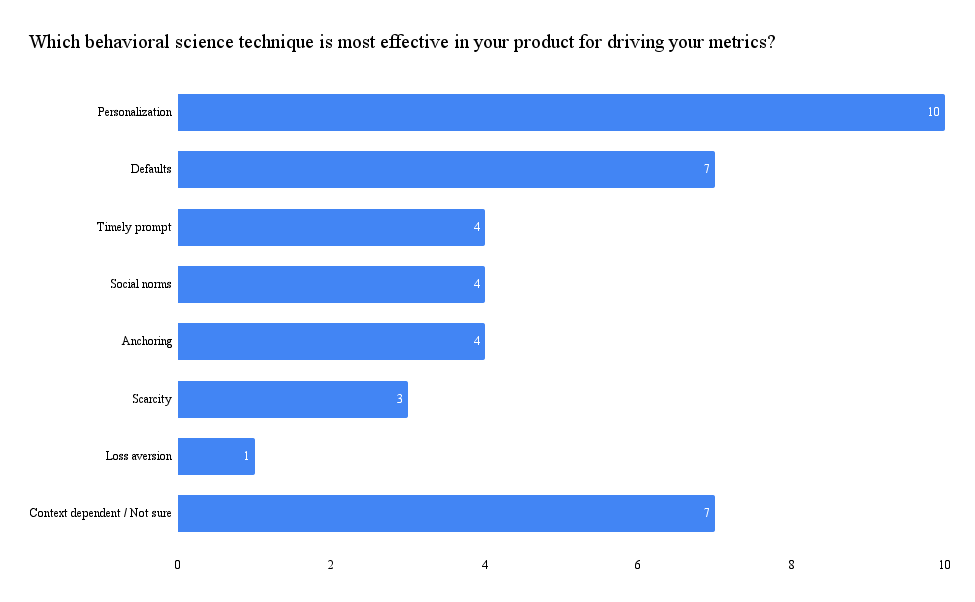This is how tech is using behavioral science today
40+ product managers, designers, and software engineers share how they use behavioral science in their jobs
Personalization and defaults are perceived as the nudges with the highest impact on metrics for product squads
I asked 42 product managers, engineers, and designers how they use behavioral science tactics in their work. I recruited participants via my own network and sharing on LinkedIn, so hardly a balanced sample. Still, the responses include technologists working in FAANG, famous start-ups, and large enterprise. These are recognised brands such as Canva, Financial Times, Meta, Airwallex, PepsiCo and Home Depot.
The survey intentionally focused on tactical or nudge-based approaches in order to understand day-to-day use cases. Of course, behavioral science has much wider implications than nudges but that is for another survey and discussion.
Alright, enough of a preamble - what did the survey find?
91% (38) of respondents said they “actively think about using psychology and behavioral science techniques (including nudges)” in their work.
Product squads are getting information on behavioral science from their own internal experiments, academic papers, or blogs and Twitter. I was surprised by how high internal experiments ranked and curious about the missed opportunity to publish and share results.
Personalization, timely prompts, defaults, and social norms are the top nudges used today. Scarcity and commitment devices are the least used. See the footnote for definitions of each of these terms.1
Finally, I asked what one technique do product squads think is most effective for driving their metrics. Here personalization and defaults emerged as the highest ranked - though some respondents stated they weren’t sure or that their answer was too context dependent (c’mon, you have to stack rank people!).
Defaults are famously one of the most effective techniques in behavioral science so it confirms an easy prior that this would be perceived as one of the most effective nudges. Product squads rank loss aversion, endowment effect, commitment devices, and scarcity as less effective. This may indicate there are further opportunities here to improve implementation but more likely it illustrates the greater perceived effectiveness of other nudges.
Finally, some of those surveyed shared stories of how they are applying behavioural science. In particular, these showed the importance of applying nudges in context and - beyond tactics - stepping back to understand the wider environment for behaviour.
“Defaults have been really effective for us in driving adoption of push notifications, a big engagement driver.”
“I wouldn't say I spend much time looking for generalised nudges. But I use BeSci to make sure the product design is geared towards a behaviour, the behaviour is understood, barriers removed and benefits amplified. And everything communicated clearly. That matters more than individual nudge techniques”
“Generally relate better in different parts of the product, i.e. anchoring/defaults works well in pricing versus scarcity in activation. Also desire to complete in activation etc.”
The definition of these items are as follows:
Personalization: Making different choices attractive for individual users
Timely prompt: Nudging your user at the right time for them to make a decision
Defaults: Setting a choice for your user that they need to actively opt-out of
Social norms: Showing users what other users are doing in your product
Endowment effect: Users are more likely to be attached to something they own
Transparency: Showing users how the product is made
Anchoring: Using a price or number to anchor your user
Loss aversion: Users will want to avoid losses more than equivalent gains
Commitment device: Ask your user to commit ahead of time to taking an action
Scarcity: Highlighting scarcity of a certain area to prompt a decision




